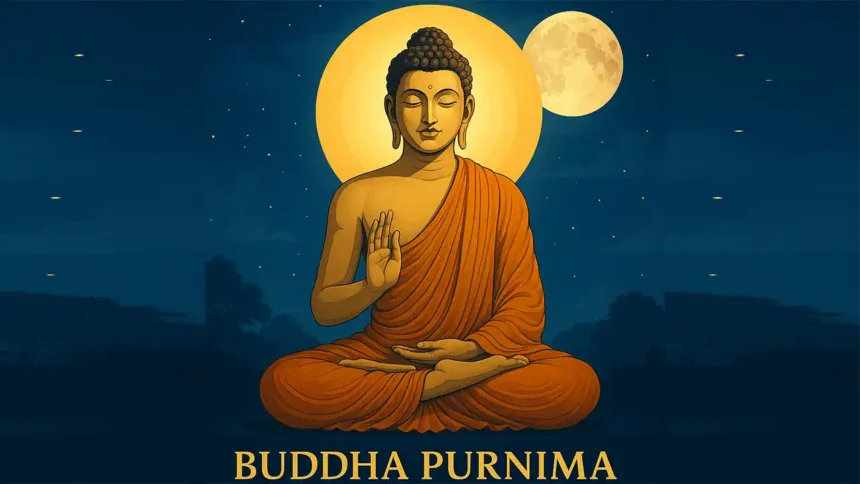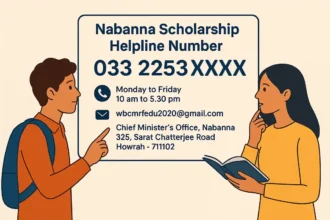Is Buddha Purnima Just a Festival, or a Spiritual Awakening?
Buddha Purnima, also known as Vesak or Buddha Jayanti, is the most sacred day for Buddhists worldwide. In 2025, it falls on Monday, May 12. This day is not just about celebrating a birth; it commemorates three significant events in the life of Gautama Buddha: his birth, enlightenment, and death (Parinirvana). These events are believed to have occurred on the same day, making Buddha Purnima a “Thrice Blessed Festival”.
The Life of Siddhartha Gautama
Birth in Lumbini
Siddhartha Gautama was born around 563 BCE in Lumbini, present-day Nepal. His mother, Queen Maya Devi, gave birth to him during a journey to her ancestral home. His father, King Śuddhodana, ruled the Shakya clan. From birth, Siddhartha was surrounded by luxury and was shielded from the sufferings of the world.
The Four Sights
At the age of 29, Siddhartha ventured outside the palace and encountered four sights that changed his life: an old man, a sick person, a dead body, and a wandering ascetic. These experiences exposed him to the realities of life—aging, sickness, and death—and inspired him to seek a path to overcome suffering.
The Quest for Enlightenment
Leaving behind his royal life, Siddhartha embarked on a spiritual quest. He practiced severe asceticism for six years but realized that extreme self-denial was not the path to enlightenment. He then adopted the Middle Way—a balanced approach between indulgence and asceticism. At the age of 35, while meditating under the Bodhi tree in Bodh Gaya, India, he attained enlightenment and became the Buddha, meaning “The Awakened One”.
Teaching the Dharma
After his enlightenment, Buddha began teaching the Dharma—the universal truths he had discovered. He traveled extensively, sharing his insights on suffering, its causes, and the path to liberation. His teachings emphasized the Four Noble Truths and the Eightfold Path as means to attain Nirvana.
Parinirvana
At the age of 80, Buddha attained Parinirvana in Kushinagar, India. This event signifies his release from the cycle of birth and death, achieving ultimate liberation.
Significance of Buddha Purnima
Buddha Purnima holds immense significance as it commemorates the three pivotal events in Buddha’s life—his birth, enlightenment, and Parinirvana—all believed to have occurred on the full moon day of the month of Vaisakha (April-May).
Spiritual Reflection
The day serves as an opportunity for spiritual reflection. Followers engage in meditation, chant sutras, and participate in discussions about Buddha’s teachings. It’s a time to contemplate the impermanence of life and the path to liberation.
Acts of Kindness
Buddha emphasized compassion and kindness. On Buddha Purnima, devotees engage in charitable acts, such as donating to the needy, feeding the hungry, and releasing animals as a symbol of liberation.
Celebrations Around the World
India
In India, Buddha Purnima is celebrated with great reverence. Temples are decorated, and devotees participate in processions, offer prayers, and engage in meditation. The Mahabodhi Temple in Bodh Gaya, where Buddha attained enlightenment, becomes a focal point for pilgrims.
Nepal
Nepal, the birthplace of Buddha, observes Buddha Purnima with various ceremonies. Lumbini, the sacred site of his birth, hosts numerous events, including prayer gatherings and cultural programs.
Sri Lanka
In Sri Lanka, the festival is known as Vesak. Homes and streets are adorned with lanterns, and devotees participate in religious activities, including sermons, meditation, and almsgiving.
Southeast Asia
Countries like Thailand, Myanmar, and Cambodia celebrate Vesak with processions, temple visits, and acts of merit. In Malaysia and China, releasing caged animals is a common practice, symbolizing the liberation of beings.
East Asia
In Japan, Buddha’s birthday is celebrated as Hana Matsuri (Flower Festival) on April 8. Temples are decorated with flowers, and a ritual of pouring sweet tea over Buddha’s statue is performed.
Buddha Purnima 2025: Date and Observance
In 2025, Buddha Purnima will be observed on Monday, May 12. The date varies each year, as it’s based on the lunar calendar, specifically the full moon day of Vaisakha.
How Is Buddha Purnima Celebrated?
Different countries have unique ways of celebrating Buddha Purnima:
1. India & Nepal
- Devotees visit Buddhist temples like Mahabodhi Temple (Bodh Gaya) and Sarnath.
- They offer prayers, light candles, and chant Buddhist scriptures.
- Many people free caged birds or donate food to the poor as a symbol of kindness.
2. Sri Lanka & Thailand
- Streets are decorated with lanterns and flags.
- People engage in meditation and listen to sermons about Buddha’s teachings.
- Some release fish or turtles into rivers as an act of compassion.
3. Japan & China
- Known as “Hanamatsuri” in Japan, people pour sweet tea over Buddha statues.
- In China, devotees visit monasteries and offer incense.
4. Western Countries
- Buddhist communities organize peaceful marches, discussions, and meditation sessions.
Common Practices During Buddha Purnima
- Visiting Temples: Devotees visit Buddhist temples to offer prayers, light candles, and incense.
- Meditation and Chanting: Engaging in meditation sessions and chanting sutras to reflect on Buddha’s teachings.(Dws Jewellery)
- Almsgiving: Providing food, clothes, or donations to monks and the needy.(Dws Jewellery)
- Releasing Animals: Symbolizing the liberation of beings, animals are released into their natural habitats.
- Decorations: Homes and streets are decorated with lanterns, flowers, and images of Buddha.
The Teachings of Buddha
Buddha’s teachings, known as the Dharma, revolve around understanding the nature of suffering and the path to overcome it.
The Four Noble Truths
- Dukkha: Life involves suffering.
- Samudaya: Suffering is caused by desire and attachment.
- Nirodha: It’s possible to end suffering.
- Magga: The Eightfold Path leads to the cessation of suffering.
The Eightfold Path
- Right View: Understanding the nature of reality and the path of transformation.
- Right Intention: Commitment to ethical and mental self-improvement.
- Right Speech: Speaking truthfully and kindly.
- Right Action: Behaving peacefully and harmoniously.
- Right Livelihood: Avoiding professions that harm others.
- Right Effort: Cultivating positive states of mind.
- Right Mindfulness: Developing awareness of the body, sensations, feelings, and states of mind.
- Right Concentration: Developing the mental focus necessary for this awareness.
The Spiritual Meaning of Buddha Purnima
Buddha Purnima is not just a festival—it’s a reminder of Buddha’s core teachings:
- Non-violence (Ahimsa) – Harming no living being.
- Compassion (Karuna) – Showing love and kindness to all.
- Mindfulness (Sati) – Being aware of thoughts and actions.
- The Middle Path – Avoiding extreme lifestyles.
On this day, Buddhists renew their commitment to following these principles.
Pilgrimage Sites Associated with Buddha Purnima
Here are four most sacred places connected to Buddha’s life:
- Lumbini (Nepal): Where Buddha was born.
- Bodh Gaya (India): Where Buddha became enlightened under the Bodhi Tree.
- Sarnath (India): Where Buddha gave his first sermon.
- Kushinagar (India): Where Buddha attained Parinirvana.
These places are visited by millions of devotees and tourists every year during Buddha Purnima.
Quotes by Lord Buddha
“Do not dwell in the past, do not dream of the future, concentrate the mind on the present moment.”
“Hatred does not cease by hatred, but only by love; this is the eternal rule.”
“Peace comes from within. Do not seek it without.”
“Health is the greatest gift, contentment the greatest wealth, faithfulness the best relationship.”
Relevance of Buddha’s Teachings Today
In today’s fast-paced world, Buddha’s teachings offer a path to inner peace and understanding. Practicing mindfulness, compassion, and ethical living can lead to a more harmonious life. Buddha Purnima serves as a reminder to incorporate these values into our daily lives.
5 Unique Facts About Buddha Purnima
- Not Always on the Same Date – Buddha Purnima falls on different dates each year because it follows the lunar calendar.
- UN Recognition – In 1999, the United Nations officially recognized Vesak as an international day of celebration.
- Buddha’s Relics – Some temples display Buddha’s relics only on this day.
- Global Celebrations – Over 500 million people celebrate Buddha Purnima worldwide.
- Symbolic Offerings – Flowers represent impermanence, while candles symbolize wisdom.
Conclusion
Buddha Purnima is more than a festival—it is a reminder. A reminder to live mindfully, act kindly, and follow the middle path. In 2025, as the full moon rises on May 12, take a moment to look within. You don’t need a temple to honor Buddha. Your thoughts, your actions, and your compassion are the real offerings.
So this Buddha Purnima, let us not just light candles in temples—let us light the candle of awareness in our hearts.
FAQs
Q: What is Buddha Purnima?
A: Buddha Purnima is a festival that commemorates the birth, enlightenment, and death of Gautama Buddha.
Q: When is Buddha Purnima in 2025?
A: It will be observed on Monday, May 12, 2025.
Q: How is Buddha Purnima celebrated?
A: Celebrations include visiting temples, meditation, chanting, almsgiving, and acts of kindness.
Q: Is Buddha Purnima a public holiday?
A: Yes, in many countries with significant Buddhist populations, including India, Nepal, Sri Lanka, and others.
Q: What is the significance of releasing animals on this day?
A: Releasing animals symbolizes the liberation of beings and the practice of compassion.





